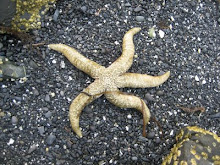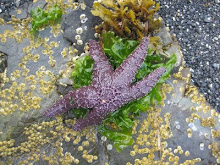A group of napping Sea Otters in Saint Johns Bay north of Sitka.
There are a lot of Sea Otter in Sitka Sound. When the Russians owned Alaska, they thought that the Sea Otter pelt was the only thing of value and when they had wiped out the Otter population, they sold off Alaska for 2 cents an acre. They planted a group of Otter from the Kodiak area to Southeast Alaska 30 or 40 years ago. Today, they have grown into a large population and you can find them all over Southeast Alaska.
Our most popular tour in Sitka Sound was called the Sea Otter and Wildlife Quest. In the 12 years we lived in Alaska, I gathered 100's of hours of Otter watching. The following is one of the most spectacular and heart warming Otter experiences that I had.
One day I was captaining a tour in the Kamenoi Island area along the Southeast side of the sound, out in front of Redoubt Bay. There was a particular route that we did that put us in close proximity to a fairly large group of Otters. The route took us in between large rocky outcroppings. It was also a good place to see Seals resting on the rocks at low tide. I had been there with passengers many times, but this particular time a very cool thing occurred.
You had to do some touchy maneuvering to get close to the Otter with shallow rocks and patches of kelp as obstacles. As I brought the 110 passenger tour catamaran up to the optimal viewing position, I suddenly heard a loud chirping sound. It wasn't a usual sound so it drew my attention. After scanning the area I found the otter that all of the chirping was coming from. This particular otter was swimming fast and seemed very agitated. It would swim one direction and then turn to another direction, almost as though it was looking for something.
Suddenly the sound of the loud chirping became muffled and I lost sight of the otter. I looked all around to try and find the location of the Otter. From time to time the chirping would sound loud and clear and then become muffled again. Finally, I spotted the Otter and realized what it was doing. It was diving down under the water and calling below the surface. It was a female who had lost its baby. As I realized what was happening I started looking for the baby Otter. As I swept the area I spotted a fuzzy ball of fur on the other side of the boat. When we came into the area the female must have left the baby on the surface while she foraged for food. We didn't realize that we had come between the female and her baby. As I slowly moved the catamaran through the area, the female finally spotted her baby floating on the surface behind and beyond our boat. She let out a load chirp and the baby heard its mother. Both otters started swimming towards one another. As I had figured out what was going on, I started interpreting the Otters behavior to the passengers on the vessel. We all watched with excitement as the two Otters were swimming towards one another. When they finally met they hugged and patted each other. It was the sweetest reunion. As the otters reveled in their reunion the passengers on the boat cheered. That single act made the whole trip for all those on board.
This is a photo of a female with her one year old pup. Females will take care of there pup until they are ready to deliver again.
Sea Otters can do all of their essential behaviors in the water but once in a while they will climb out and rest on a kelp covered rock. They don't have thick blubber so sharp rocks are not as comfortable as the sea.
Otters know that they are out of their element when they are out of the water. If you get to close they will escape to the water fast.
Blond headed Otters are older Otters. Just like humans get gray as they age, Otters go blond.
This Otter is busy eating an octopus. Sea Otters are opportunistic eaters and when they are eating you can get closer than normal to them. If other Otters find out that it has an octopus, they will take it away so Otters were all business when eating a meal.
Another time, I came upon a newborn Sea Otter while on a tour. The baby Otter looked like a ball of fur. It floated very high in the water and at first I thought it was some sort of garbage. Baby Otters are very buoyant so that they won't drown before they learn to swim. Female Otters will pull their babies under the water to get them use to swimming. Of course, some of the tourists on the boat thought that the baby Otter had been abandoned and I had to teach them that it is never a good idea to take a baby animal out of the wild unless you are absolutely certain that the mother has died or been killed.
One day I came upon a sleeping Otter while on tour. Usually the Otter will wake up when you get too close but this guy was fast asleep. I kept getting closer and closer. Finally, the boat softly nudged the Otter and it woke with explosive furry. I wouldn't want to wake up to 49 people looking down at me either. I actually felt bad for waking the poor guy from such a deep and restful sleep.
In 1996, I witnessed a group of ten Orca teaching their young how to hunt by practicing with an adult Sea Otter. In the end they didn't kill the Otter, but they pounced on him and swatted him back and forth like a beach ball. The whole incident took about 20 minutes and then as fast as the drama began, off the pod went and we stayed to see the poor Otter swim to the shore and slowly drag himself up on the bank as if every bone in his body was broken.
Otters have very little body fat. They are just one big fir ball so an Orca would really rather make a meal of a juicy and blubbery seal or sea lion.
Orca are really family oriented and stay together in their own clans. Many times, out on tour,
I have come upon a cow, a bull, and a calf or two moving through Sitka Sound on their never ending quest for food.
The caption for this photo should be, "bye"!































